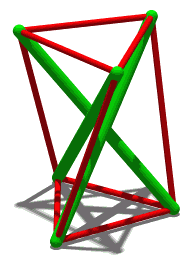
Tensegrity, tensional integrity or floating compression is a structural principle based on a system of isolated components under compression inside a network of continuous tension, and arranged in such a way that the compressed members do not touch each other while the prestressed tensioned members delineate the system spatially.

The Hirshhorn Museum and Sculpture Garden is an art museum beside the National Mall in Washington, D.C., United States. The museum was initially endowed during the 1960s with the permanent art collection of Joseph H. Hirshhorn. It was designed by architect Gordon Bunshaft and is part of the Smithsonian Institution. It was conceived as the United States' museum of contemporary and modern art and currently focuses its collection-building and exhibition-planning mainly on the post–World War II period, with particular emphasis on art made during the last 50 years.
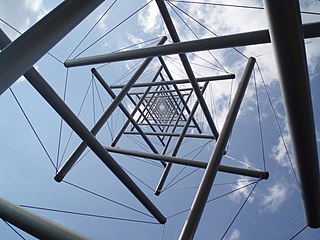
Kenneth Duane Snelson was an American contemporary sculptor and photographer. His sculptural works are composed of flexible and rigid components arranged according to the idea of 'tensegrity'. Snelson preferred the descriptive term floating compression.
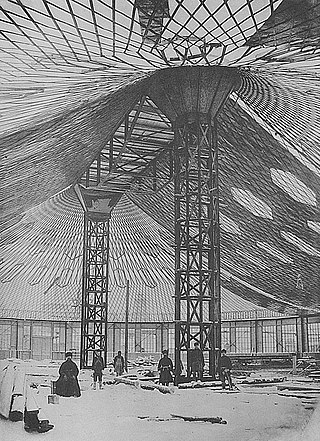
In structural engineering, a tensile structure is a construction of elements carrying only tension and no compression or bending. The term tensile should not be confused with tensegrity, which is a structural form with both tension and compression elements. Tensile structures are the most common type of thin-shell structures.

Metals used for architectural purposes include lead, for water pipes, roofing, and windows; tin, formed into tinplate; zinc, copper and aluminium, in a range of applications including roofing and decoration; and iron, which has structural and other uses in the form of cast iron or wrought iron, or made into steel. Metal alloys used in building include bronze ; brass ; monel metal and nickel silver, mainly consisting of nickel and copper; and stainless steel, with important components of nickel and chromium.
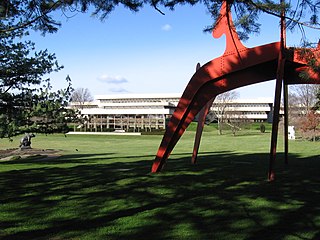
The Donald M. Kendall Sculpture Gardens is a collection of 45 pieces of outdoor sculpture at the PepsiCo world headquarters in Purchase, New York. The collection includes work from major modern sculptors including Auguste Rodin, Henry Moore, Alexander Calder, and Alberto Giacometti.

The Kurilpa Bridge is a A$63 million pedestrian and bicycle bridge over the Brisbane River in Brisbane, Queensland, Australia. The bridge connects Kurilpa Point in South Brisbane to Tank Street in the Brisbane central business district. In 2011, the bridge was judged World Transport Building of the Year at the World Architecture Festival.

Chryssa Vardea-Mavromichali was a Greek American artist who worked in a wide variety of media. An American art pioneer in light art and luminist sculpture, known for her neon, steel, aluminum and acrylic glass installations, she always used the mononym Chryssa professionally. She worked from the mid-1950s in New York City studios and worked since 1992 in the studio she established in Neos Kosmos, Athens, Greece.

Throwback is a public artwork by American artist Tony Smith, located at the Hirshhorn Museum and Sculpture Garden in Washington, D.C., United States. This version is the third of an edition of three in the series with one artist's proof.

Antipodes is a public artwork by American sculptor Jim Sanborn located outside of the Hirshhorn Museum and Sculpture Garden in Washington, DC, United States.

Last Conversation Piece is a public artwork by Spanish sculptor Juan Muñoz in the collection of the Hirshhorn Museum and Sculpture Garden in Washington, DC, United States. The piece is currently on loan to The Contemporary Austin.

Are Years What? is a sculpture by American artist Mark di Suvero. It is in the collection of the Hirshhorn Museum and Sculpture Garden, in Washington, D.C., United States. The sculpture is named after poet Marianne Moore's "What Are Years". From May 22, 2013 through May 26, 2014, the sculpture resided temporarily in San Francisco, as part of the San Francisco Museum of Modern Art's Mark di Suvero exhibition at Crissy Field.
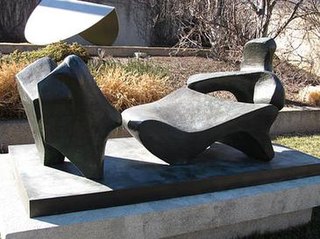
Three-Piece Reclining Figure No. 2: Bridge Prop is a sculpture by Henry Moore, created in 1963, and produced in an edition of six copies.
Kiepenkerl was originally a sandstone statue of a travelling merchant created by August Schmiemann in Münster, Germany in 1896. Destroyed in World War II, it was re-created in cast metal by Albert Mazzotti Jr in 1953. The statue now stands in a small square in the Old Quarter of Münster. In 1987 American sculptor Jeff Koons created a replica of the design in polished cast stainless steel.
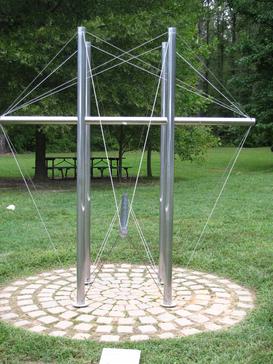
Six Number Two is a stainless steel sculpture by Kenneth Snelson.

Nancy Rubins is an American sculptor and installation artist. Her sculptural works are primarily composed of blooming arrangements of large rigid objects such as televisions, small appliances, camping and construction trailers, hot water heaters, mattresses, airplane parts, rowboats, kayaks, canoes, surfboards, and other objects. Works such as Big Edge at CityCenter in Las Vegas contain over 200 boat vessels. Stainless Steel, Aluminum, Monochrome I, Built to Live Anywhere, at Home Here, at the Albright-Knox Art Gallery in Buffalo, contains 66 used aluminum boats and rises to a height of 30 ft.

The South Tower is a stainless steel outdoor sculpture depicting the South Tower of the World Trade Center the moment before it collapsed during the attacks on September 11, 2001. Created as a tribute to the victims of the attack and designed by American artist Don Gummer, it is located on the Indiana University-Purdue University Indianapolis (IUPUI) campus, near downtown Indianapolis, Indiana, and owned by the artist. The sculpture is made of frosted stainless steel aluminum.
Untitled is a 1986 stainless steel sculpture by Ellsworth Kelly, installed at the Hirshhorn Museum and Sculpture Garden, in Washington, D.C., United States. The sculpture measures 78 inches (200 cm) x 135.25 inches (343.5 cm) x 129.75 inches (329.6 cm).
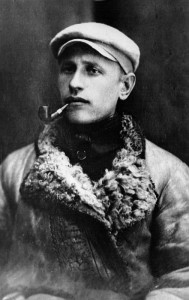
Karl Johansson was a Latvian-Soviet avant-garde artist.


















